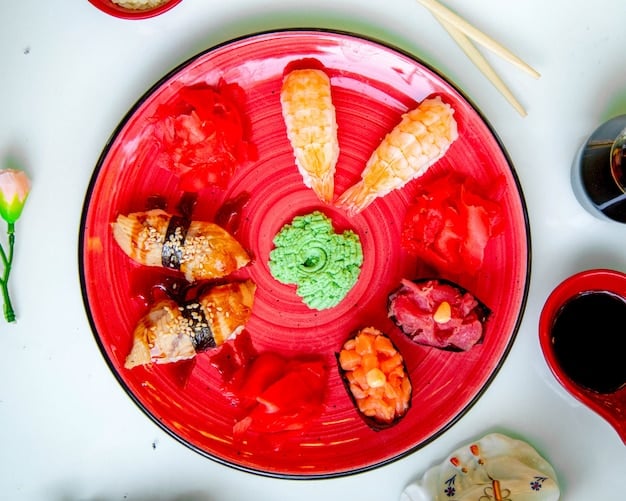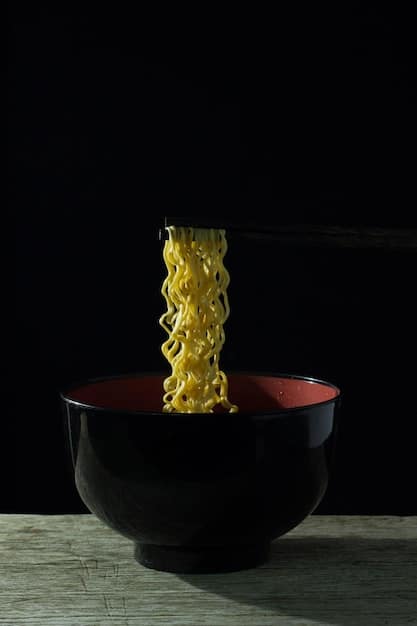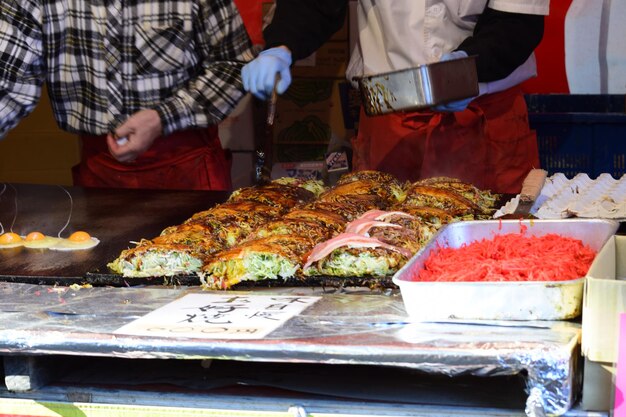Japan’s Foodie Paradise: A US Culinary Journey in 2025

Japan’s Foodie Paradise: A Culinary Journey for US Palates in 2025 promises an immersive experience into Japan’s diverse culinary landscape, offering unique flavors, traditional dishes, and innovative gastronomy tailored to American tastes, ensuring an unforgettable travel adventure.
Embark on an unforgettable gastronomic adventure in 2025 as we explore Japan’s Foodie Paradise: A Culinary Journey for US Palates, a land where ancient traditions meet modern innovation, creating a symphony of flavors that will tantalize your taste buds.
A Culinary Awakening: Why Japan in 2025?
Japan has long been revered for its rich cultural heritage and breathtaking landscapes. But beyond the temples and cherry blossoms lies a culinary scene that’s nothing short of a masterpiece. In 2025, a trip to Japan offers an evolved food experience, blending the timeless with the avant-garde.
The Evolution of Japanese Cuisine
Japanese cuisine is not static. It’s a constantly evolving art form, embracing new techniques, ingredients, and influences while respecting its roots. This evolution makes Japan a particularly exciting destination for food lovers in 2025.
Meeting the American Palate
Japanese chefs are increasingly aware of and catering to international tastes, including the American palate. Whether it’s through subtle tweaks to traditional dishes or the creation of entirely new culinary concepts, there’s a conscious effort to bridge the gap between cultures.
- **Enhanced Vegan and Vegetarian Options:** Reflecting global trends, Japan now offers an impressive array of vegan and vegetarian choices, from traditional Buddhist cuisine (shojin ryori) to innovative plant-based versions of classic dishes.
- **Gluten-Free Awareness:** Gluten-free options are becoming more prevalent, making it easier for those with dietary restrictions to enjoy Japanese food without worry.
- **Accessibility and Language Support:** English menus and staff who speak English are increasingly common in tourist areas, ensuring a smoother and more enjoyable dining experience for US travelers.
In conclusion, Japan’s culinary landscape in 2025 is a harmonious blend of tradition and innovation, catering specifically to the evolving tastes and preferences of American travelers.

Must-Try Culinary Experiences in Japan
Japan offers a multitude of culinary experiences that every foodie should try, from world-renowned sushi to humble street food. Each region boasts its own specialties and unique flavors, ensuring an adventure for your tastebuds.
Sushi and Sashimi: The Quintessential Japanese Dish
No culinary journey to Japan is complete without indulging in sushi and sashimi. The art of sushi lies in the freshness of the ingredients, the precision of the knife skills, and the balance of flavors. From high-end omakase experiences to conveyor belt sushi restaurants, there’s a sushi experience for every budget.
Ramen: A Noodle Lover’s Dream
Ramen is more than just a noodle soup; it’s a cultural icon. Every region in Japan has its own unique take on ramen, from the tonkotsu ramen of Fukuoka to the miso ramen of Hokkaido. Slurping a bowl of steaming ramen is a must-do for any visitor.
- **Explore Regional Variations:** Try different types of ramen in different regions to discover your favorite.
- **Visit a Ramen Alley:** Experience the vibrant atmosphere of a ramen alley, where small, family-run shops compete to serve the best bowl.
- **Customize Your Order:** Don’t be afraid to ask for modifications to your ramen, such as extra toppings or a different level of spiciness.
In essence, Japan’s culinary experiences, whether sophisticated sushi or comforting ramen, provide a deep dive into the nation’s dedication to quality and innovation in the culinary arts.
Navigating Japan’s Food Culture: Tips for US Travelers
While Japan’s culinary scene is incredibly welcoming, understanding a few cultural nuances can enhance your experience and ensure you enjoy every bite. Here are some tips on navigating Japan’s food culture.
Understanding Dining Etiquette
Japanese dining etiquette is all about respect and consideration for others. Knowing a few basic rules can go a long way in showing your appreciation for the food and the culture. For example, it is considered polite to say “itadakimasu” before eating and “gochisousama deshita” after finishing your meal.
Tipping in Japan
Tipping is not customary in Japan and can even be considered rude. Instead of tipping, focus on expressing your gratitude and appreciation for the service you received.
- **No Tipping:** Never leave a tip at restaurants, bars, or any other service establishment.
- **Show Appreciation:** Instead of tipping, thank your server or chef for their excellent service.
- **Gift Giving:** In some formal situations, such as staying at a traditional ryokan, a small gift may be appropriate instead of a tip.
Overall, navigating Japan’s food culture involves embracing its unique customs and showing respect for its rich heritage, ultimately leading to a more rewarding and meaningful travel experience.
Regional Delights: Exploring Japan’s Diverse Flavors
Japan’s culinary landscape is as diverse as its geography, with each region boasting its own unique ingredients, dishes, and cooking styles. Exploring these regional delights is essential for a comprehensive culinary journey.
Osaka: The Nation’s Kitchen
Osaka is known as “tenka no daidokoro” (the nation’s kitchen) for its vibrant food scene and its residents’ love of eating. Street food is particularly popular in Osaka, with dishes like takoyaki (octopus balls) and okonomiyaki (savory pancake) being must-tries.
Kyoto: Refined and Elegant Cuisine
Kyoto, the ancient capital of Japan, is known for its refined and elegant cuisine. Kaiseki, a traditional multi-course meal, is a highlight of Kyoto’s culinary scene, showcasing the freshest seasonal ingredients and intricate presentation.
Sapporo, located on the northern island of Hokkaido, is famous for its hearty and comforting dishes. Miso ramen, Jingisukan (grilled mutton), and seafood are among the culinary highlights of Sapporo.
- **Plan a Culinary Itinerary:** Research regional specialties and plan your trip around the foods you want to try.
- **Visit Local Markets:** Explore local markets to discover unique ingredients and regional produce.
- **Take a Cooking Class:** Learn how to prepare regional dishes from local chefs.
In conclusion, exploring Japan’s regional culinary offerings provides a rich, varied experience that highlights the country’s extensive gastronomic creativity and cultural diversity.

Foodie Accommodations: Ryokans and Culinary Stays
To fully immerse yourself in Japan’s foodie paradise, consider staying in accommodations that offer unique culinary experiences. Ryokans (traditional Japanese inns) and culinary-focused hotels provide opportunities to savor the best of Japanese cuisine in an intimate and authentic setting.
Ryokans: A Taste of Traditional Hospitality
Ryokans offer a unique blend of traditional Japanese hospitality and culinary excellence. Many ryokans feature on-site restaurants that serve exquisite kaiseki meals, showcasing the region’s seasonal ingredients.
Culinary Stays: Hotels with a Focus on Food
Some hotels in Japan are specifically designed for food lovers, offering cooking classes, food tours, and access to exclusive dining experiences. These culinary stays provide a convenient and immersive way to explore Japan’s food scene.
Benefits of Choosing Foodie Accommodations
- **Access to Exclusive Dining Experiences:** Enjoy meals prepared by top chefs using the freshest local ingredients.
- **Immersive Cultural Experiences:** Learn about Japanese food culture through cooking classes, food tours, and interactions with local chefs.
- **Convenience and Comfort:** Enjoy the convenience of having excellent food right at your doorstep, without having to venture far from your accommodation.
In summary, selecting accommodations that prioritize culinary experiences offers a deeper, more intimate connection to Japan’s cuisine, enriching the travel experience immensely.
Sustainable Eating in Japan: A Growing Trend
As awareness of environmental issues grows, sustainable eating is becoming increasingly important in Japan. Many restaurants are now focusing on using locally sourced, seasonal ingredients and reducing food waste. As a US traveler, supporting these establishments contribute to creating a positive impact.
Farm-to-Table Initiatives
Farm-to-table initiatives are gaining popularity in Japan, with restaurants partnering with local farmers to source fresh, seasonal produce. This not only supports local agriculture but also ensures that diners are enjoying the best possible flavors.
Zero-Waste Restaurants
Some restaurants in Japan are taking sustainability to the next level by implementing zero-waste practices. These restaurants strive to minimize their environmental impact by reducing, reusing, and recycling materials, as well as composting food waste.
Tips for Sustainable Eating in Japan
- **Choose Restaurants with Local Ingredients:** Look for restaurants that emphasize the use of locally sourced, seasonal ingredients.
- **Support Zero-Waste Establishments:** Patronize restaurants that are committed to reducing waste and minimizing their environmental impact.
- **Be Mindful of Food Waste:** Avoid ordering more food than you can eat, and consider taking leftovers with you.
Therefore, participating in sustainable eating habits while in Japan allows US travelers to enjoy culinary delights while also supporting responsible environmental practices.
Planning Your Culinary Trip: Practical Tips and Resources
Planning a culinary trip to Japan requires careful consideration of your interests, budget, and travel style. Here are some practical tips and resources to help you create the perfect foodie adventure.
When to Visit Japan
The best time to visit Japan for a culinary trip depends on your interests and preferences. Spring (March-May) and autumn (September-November) are popular times to visit, as the weather is mild and the scenery is beautiful. However, each season offers unique culinary experiences, so consider what foods you want to try when planning your trip.
Budgeting for Your Trip
Japan can be an expensive destination, but it’s possible to enjoy a culinary trip on a budget. Consider staying in budget-friendly accommodations, eating at local restaurants, and taking advantage of free activities.
Useful Resources for Planning
- **Japan National Tourism Organization (JNTO):** The official website of JNTO provides valuable information on travel planning, including visa requirements, transportation, and accommodation.
- **Gurunavi and Tabelog:** These websites are popular resources for finding restaurants in Japan, with user reviews and detailed information on menus, prices, and ambiance.
- **Cookly:** This platform offers a variety of cooking classes and food tours in Japan, allowing you to learn about Japanese cuisine from local experts
In conclusion, with careful planning and thoughtful preparation, a culinary trip to Japan can be an incredibly rewarding and enjoyable experience, rich in flavor and culture.
| Key Point | Brief Description |
|---|---|
| 🍣 Sushi & Sashimi | Must-try Japanese dish, highlighting fresh ingredients. |
| 🍜 Regional Ramen | Each region offers its unique ramen style. |
| 🥢 Dining Etiquette | Respectful dining customs enhance the experience. |
| 🌱 Sustainable Eating | Support local and zero-waste restaurants. |
Frequently Asked Questions
▼
Look for yuzu (citrus fruit), shiso (herb), and konjac (root vegetable). These ingredients can elevate dishes with their distinctive flavors and textures.
▼
Seek out shojin ryori (Buddhist cuisine) or look for restaurants with vegan or vegetarian menus. Apps like HappyCow can also assist in finding plant-based options.
▼
Many gardens and cultural centers in Japan offer tea ceremonies. Booking in advance is recommended to ensure availability and a more intimate experience.
▼
While awareness is growing, it’s best to carry a card in Japanese detailing your allergies. This will help ensure clear communication with restaurant staff.
▼
It’s customary to pour drinks for others and to allow someone else to pour for you. Always hold your glass when someone is pouring and say “kanpai” (cheers) before drinking.
Conclusion
Japan’s Foodie Paradise: A Culinary Journey for US Palates in 2025 promises to be an unforgettable experience, blending traditional flavors with modern innovations, and offering something to satisfy every palate. From bustling street food markets to elegant ryokans, Japan’s diverse culinary landscape awaits, offering a delicious adventure you won’t soon forget.





